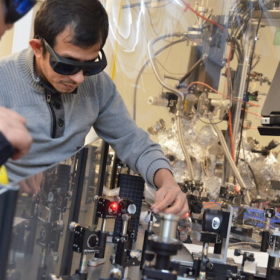
Scientists from the University of Kansas say adding a layer of two-dimensional semiconductor molybdenum disulfide can greatly improve the performance of organic solar cells. The research could also inform efforts to engineer the interface between layers in hybrid organic cells.
A team of scientists at the University of Kansas has found combining organic semiconductor zinc phthalocyanine with a single layer of molybdenum disulfide atoms can greatly improve the material’s performance as a solar cell.
Using photoemission spectroscopy equipment the team was able to observe the behavior of electrons in the material. That led to several discoveries about the interface between the two materials which the researchers say could enable them to determine new directions for research into organic solar cells and two-dimensional semiconductors.
“One of the prevailing assumptions is free electrons can be generated from the interface as long as electrons can be transferred from one material to another in a relatively short period of time – less than one-trillionth of a second,” said Wai-Lun Chan, associate professor of physics and astronomy at the University of Kansas. “However, my graduate students and I have found the presence of the ultrafast electron transfer in itself is not sufficient to guarantee the generation of free electrons from the light absorption. That’s because the ‘holes’ can prevent the electrons from moving away from the interface. Whether the electron can be free from this binding force depends on the local energy landscape near the interface.”
Tracking electron journeys
The experiments are described in the paper Effect of the Interfacial Energy Landscape on Photoinduced Charge Generation at the ZnPc/MoS2 Interface, published in the Journal of the American Chemical Society. The team used a laser pulse lasting 10-14 (ten quadrillionths) of a second to set electrons into motion and then a second pulse to kick electrons out of the sample.
That enabled the scientists to calculate the journey taken by the electrons after the first laser pulse and their position relative to the interface.
The researchers say that their findings will enable further research to develop principles for the design of hybrid organic PV cells. “These detailed measurements enabled us to reconstruct the trajectory of the electron and determine conditions that enable the effective generation of free electrons,” said Hui Zhao, professor of physics and astronomy at the University of Kansas and a co-author of the paper.
Lắp đặt điện mặt trời Khải Minh Tech
https://ift.tt/2X7bF6x
0906633505
info.khaiminhtech@gmail.com
80/39 Trần Quang Diệu, Phường 14, Quận 3
Lắp đặt điện mặt trời Khải Minh Tech
https://ift.tt/2ZH4TRU
Không có nhận xét nào:
Đăng nhận xét